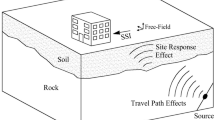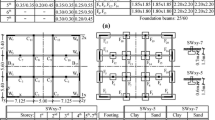Abstract
The September 19, 2017 earthquake with epicenter in the Mexican Republic caused dozens of collapses of reinforced concrete buildings in Mexico City. A high percentage of these buildings on transition and soft soil sites, had a weak first story. In addition to the known seismic vulnerability of these buildings, other parameters as frequency content of the seismic records, seismic regulation, soil type, among others, influenced the collapse of the structures as well. Altogether, they explain better why the collapses occurred in some specific areas and in others, with similar intensities, did not generate the failure of the structures. Most of the buildings that partially or totally collapsed during the September 19, 2017 earthquake rested on soft soils. Additionally, many of them had a parking area supported by columns and beams on the first floor and apartments on the upper floors, supported by confined masonry walls, creating a weak ground-floor structure. This study evaluates the main parameters that influenced the observed collapses of buildings with weak ground floors during the September 19, 2017 earthquake. Nonlinear analyses of the buildings subjected to unscaled real accelerograms recorded during the earthquake were carried out. The results show that the following factors jointly contributed to the collapse of buildings: design criteria of the seismic regulation in force during the construction period of the buildings, the building height, the soil type on the building location, the frequency content of the seismic records and the soil-structure interaction.




























Similar content being viewed by others
Data availability
The datasets generated during and/or analysed during the current study are available from the corresponding author on reasonable request.
References
Arslan MH, Korkmaz HH (2007) What is to Be learned from damage and failure of reinforced concrete structures during recent earthquakes in Turkey. J Eng Fail Anal 14:1–22
ASCE (2017) Seismic Evaluation and Retrofit of Existing Buildings, American Society of Civil Engineers, Virginia, USA. ASCE/SEI 41–17
Benavent-Climent A, Mota-Paez S (2017) Earthquake retrofitting of R/C frames with soft first story using hysteretic dampers: energy-based design method and evaluation. Eng Struct 137:19–32
CICM (2017) Preliminary Report of the Inspected Buildings after the September 19, 2017 Earthquake, College of Civil Engineers of Mexico, México, (In Spanish).
Clough R, Johnston S (1966) Effect of stiffness degradation on earthquake ductility requirements. In: Proceedings of the 2nd Japan Earthquake Engineering Symposium, Tokyo
Dogangün A (2004) Performance of reinforced concrete buildings during the May 1, 2003 Bingöl earthquake in Turkey. Eng. Struct. 26:841–856
Dya AFC, Oretaa AWC (2015) Seismic vulnerability assessment of soft story irregular buildings using pushover analysis. Procedia Eng 125:925–932
CSI ETABS, Computer and Structures Inc., Berkeley, CA, 2020.
FEMA 356 (2000) Prestandard and Commentary for the Seismic Rehabilitation of Buildings, Federal Emergency Management Agency. American Society of Civil Engineers, Washinghton D.C, 2000.
Florio E (2022) Influence of soil structure interaction in buildings with flexible ground floor in Mexico City. MSc Thesis, School of Civil Engineering, Universidad Michoacana de San Nicolás de Hidalgo
Furtado A, Rodrigues H, Varum H, Costa A (2014) Assessment and strengthening strategies of existing RC buildings with potential soft-storey response, in: 9th International Masonry Conference, Guimaraes, Portugal, pp 1–9
Guevara-Pérez LT (2015) Soft story and weak story in earthquake resistant design: a multidisciplinary approach. In: 15th World conference on earthquake engineering, Lisbon, Portugal, pp 856–865
Jara JM, Hernández EJ, Olmos BA, Martínez G (2020) Building damages during the September 19, 2017 earthquake in Mexico City and seismic retrofitting of existing first soft-story buildings. Eng Struct 209:109977
Jara JM, García-Calzada C, Olmos BA, Martínez G (2022) Seismic response and reliability index of RC weak story buildings on soft soils of Mexico city. J Build Eng 50:104199
K. Adalier, O. Aydingun, Structural engineering aspects of the June 27 (1998) Structural engineering aspects of the June 27, 1998 Adana-Ceyhan (Turkey) earthquake. Eng Struct 23(2001):343–355
Kalateh-Ahani M, Amiri S (2021) A Park-Ang damage index-based framework for post-mainshock structural safety assessment. Structures 33:820–829
Khan D, Rawat A (2016) Nonlinear seismic analysis of masonry infill RC buildings with eccentric bracings at soft storey level. Procedia Eng 161:9–17
Kirac N, Dogan M, Ozbasaran H (2011) Failure of weak-storey during earthquakes. Eng Fail Anal 18:572–581
Makris N, Moghimi G (2019) Displacements and Forces in Structures with Inerters when Subjected to Earthquakes. J Struct Eng 145:1–14
Mander JB, Priestley MJ, Park R (1998) Theoretical stress–strain model for confined concrete. J Struct Div ASCE 144(8):1804–1826
MOC (2015) Seismic Design. Design Manual for Civil Works. Electrical Research Institute (IIE), México
NTC DF-Sismo (1976) Complementary Technical Norms for Reinforcement Concrete Design, Federal District's government, 1976 (In Spanish).
NTC DF-Sismo (2004) Complementary Technical Norms for Earthquake Resistant Design, Federal District's government, 2004 (In Spanish).
NTC, Mexico City (2017) Technical Regulation for Reinforcement Concrete Design, Diario Oficial de la Federación, 2017 (in Spanish).
NTC, Mexico City (2020a) Technical Regulation for Seismic Design. Diario Oficial de la Federación (in Spanish).
NTC, Mexico City (2020b) Technical Regulation for Design and Construction of Masonry Structures. Diario Oficial de la Federación, 2020b (in Spanish).
Páez D, Zabala J, Rodriguez Y (2017) Weak floor, common failure in Pedernales earthquake. Ciencia, 19: 59–75. https://doi.org/10.24133/ciencia.v19i1.327
Park YJ, Ang AHS (1985) Mechanistic seismic damage model for reinforced concrete. J Struct Eng 111(4):722–739
Park R, Paulay T (1975) In: Reinforced concrete structures. Wiley first ed., United States of America, pp 36–45
Pérez JJ (2012) Guide for the analysis of masonry structures. Consejo Nacional de Ciencia y Tecnología (CONACYT) & Fondo Sectorial de la Comisión Nacional para el Fomento de la Vivienda (CONAFOVI), México (In Spanish).
CSI PERFORM 3D, Computer and Structures Inc., Berkeley, CA, 2015.
RCDF (1976) District Federal Department. Technical Regulation for Seismic Design. Diario Oficial de la Federación, 14 de diciembre de 1976. México: Distrito Federal 1976 (in Spanish)
Saatcioglu M, Ghobarah A, Nistor I (2006) Performance of structures in Indonesia during the December 2004 Great Sumatra earthquake and Indian ocean tsunami, Earthq. Spectra; 22: 295–319
Sahoo DR, Rai DC (2013) Design and evaluation of seismic strengthening techniques for reinforced concrete frames with soft ground story. Eng Struct; 56 1933–1944
SASID, System of seismic actions. https://sasid.unam.mx/webNormasCDMX/. Last access April 7 2022
Sezen H, Whittaker AS, Elwood KJ, Mosalam KM (2003) Performance of reinforced concrete buildings during the August 17, 1999 Kocaeli, Turkey earthquake, and seismic design and construction practice in Turkey. Eng Struct; 25:103–114
Swain SS, Patro SK (2015) Seismic protection of soft storey buildings using energy dissipation device. In: Matsagar V (ed) Advances in structural engineering. Dynamics, vol. 2. https://doi.org/10.1007/978-81-322-2193-7_102:1311-1338.
Acknowledgements
The authors gratefully acknowledge the CONACYT for the scholarship of the second author during his MSc studies at the Universidad Michoacana de San Nicolás de Hidalgo, Morelia, Michoacán, México. The authors also thank to the Coordination of Scientific Research of the Universidad Michoacana de San Nicolás de Hidalgo for the facilities provided to carry out the study and Dr. Héctor Raúl Aguilar-Becerril for the information provided on the dynamic characteristics of soft soils in Mexico City.
Funding
The authors declare that no funds, grants, or other support were received during the preparation of this manuscript.
Author information
Authors and Affiliations
Contributions
JMJ: responsible for writing the manuscript, formal analysis, data curation, supervision and reviewing the results. EF: creation of numerical models, data curation, validation and creation of figures and tables, participation in writing the initial draft. BAO: formal analysis, data curation, supervision and reviewing the results. GM: formal analysis, data curation, supervision and reviewing the results.
Corresponding author
Ethics declarations
Conflict of interest
The authors have no relevant financial or non-financial interests to disclose.
Additional information
Publisher's Note
Springer Nature remains neutral with regard to jurisdictional claims in published maps and institutional affiliations.
Rights and permissions
Springer Nature or its licensor (e.g. a society or other partner) holds exclusive rights to this article under a publishing agreement with the author(s) or other rightsholder(s); author self-archiving of the accepted manuscript version of this article is solely governed by the terms of such publishing agreement and applicable law.
About this article
Cite this article
Jara, J.M., Florio, E., Olmos, B.A. et al. Factors influencing soft-story building failures during the September 19, 2017 earthquake in Mexico. Bull Earthquake Eng 21, 4589–4614 (2023). https://doi.org/10.1007/s10518-023-01701-2
Received:
Accepted:
Published:
Issue Date:
DOI: https://doi.org/10.1007/s10518-023-01701-2




